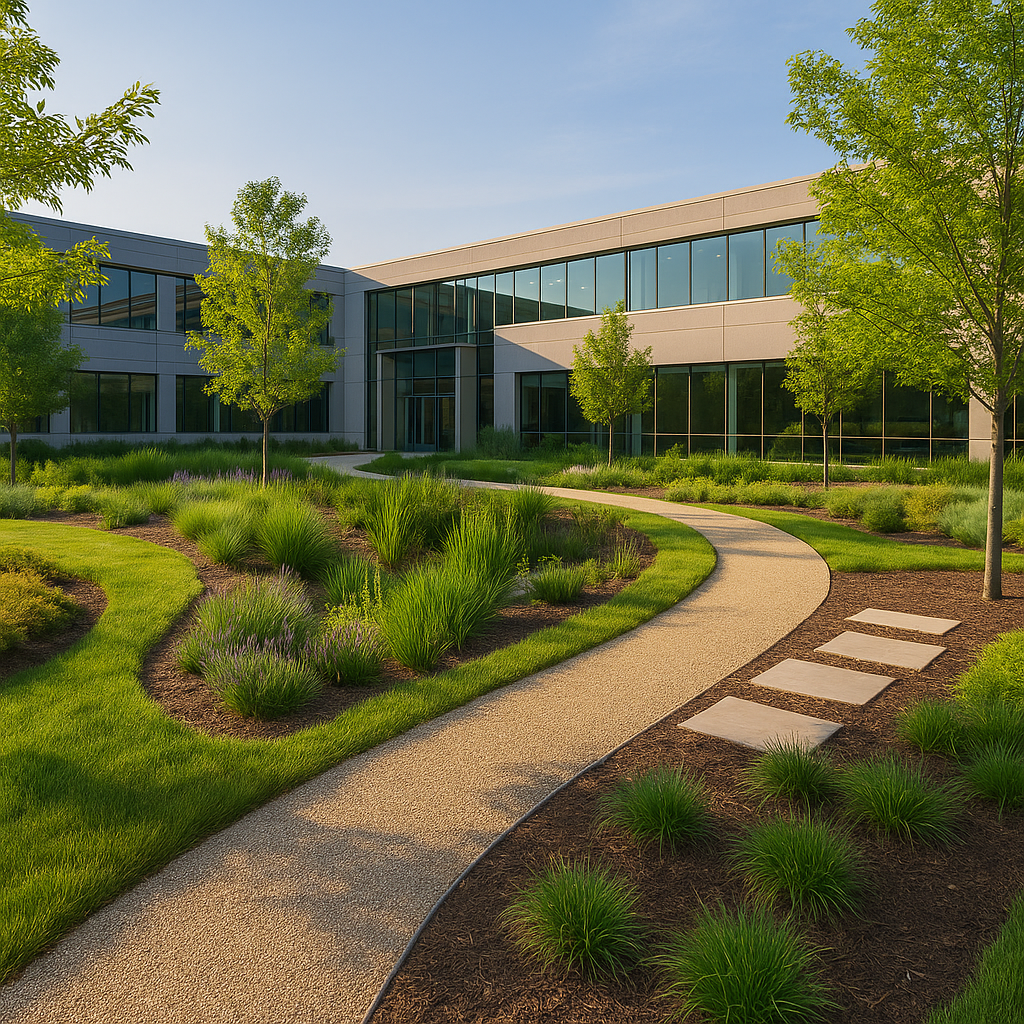In today’s environmentally conscious corporate world, the exterior design of office properties is just as important as their interiors. A beautiful landscape is no longer only about aesthetics—it is about contributing to ecological health, employee well-being, and corporate responsibility. When guided by expert planning and sustainable strategies, landscaping becomes a high-impact investment for future-forward office environments.
This article offers in-depth guidance on designing eco-friendly office landscapes and explores proven techniques, green technologies, and design frameworks to create beautiful, sustainable outdoor spaces.
Why Sustainable Landscape Design Matters for Offices
Environmental Benefits
Eco-friendly landscape design reduces water consumption, improves air quality, and supports biodiversity. By using native plants, efficient irrigation, and low-emission practices, businesses can minimize their environmental footprint.
Brand and Reputation
A commitment to sustainability reflects positively on an organization’s values. An office with a beautiful landscape that also demonstrates ecological awareness enhances brand image, investor trust, and community relationships.
Employee Wellness and Productivity
Sustainable landscapes often include wellness-friendly elements such as green walkways, edible gardens, and shaded seating—all of which improve morale and physical health. Learn more in Beautiful Landscape Features That Boost Workplace Wellness.
Key Elements of Eco-Friendly Landscape Design Architecture
Sustainable Materials
Choose hardscape materials that are locally sourced, permeable, or recycled. Examples include reclaimed wood for benches, porous pavers for walkways, and crushed stone for drainage systems.
Green Roofing and Vertical Gardens
In dense urban campuses, space-efficient landscaping such as living walls and rooftop gardens add greenery without expanding the building’s footprint.
Landscape Drawing and Site Planning
Every project starts with a comprehensive landscape drawing created by an experienced professional. These plans should incorporate sun and shade mapping, water flow, wind patterns, and energy use. Collaborating with a skilled landscape contractor ensures accurate implementation of eco-friendly practices.
Sustainable Plant Selection and Management
Native and Drought-Tolerant Plants
Select plants that thrive in local conditions without extra irrigation. These species also resist pests naturally, reducing the need for chemical treatments.
Pollinator-Friendly Gardens
Incorporate flowering species that attract bees, butterflies, and hummingbirds to support local ecosystems. These beautiful additions add movement and vibrancy to the landscape.
Efficient Irrigation Systems
Install drip irrigation or smart systems with weather-based controllers to reduce water waste. Rainwater harvesting setups can further optimize water usage.
Smart Lighting and Energy Efficiency
Solar-Powered Lighting
Utilizing solar-powered LEDs reduces grid reliance and operational costs. These can be used to illuminate walkways, signs, and focal features while maintaining eco-consciousness.
Motion Sensors and Timers
Automated lighting reduces unnecessary energy usage and provides security without compromising sustainability goals.
See practical applications of lighting in Beautiful Landscape Design Ideas for Office Park Entryways.
Biodiversity, Water Management, and Soil Health
Rain Gardens and Bioswales
These features capture runoff and allow it to percolate into the ground naturally, filtering pollutants and replenishing groundwater.
Composting Zones
Create dedicated areas for composting landscape waste, which can be reused as nutrient-rich mulch or soil conditioner.
Soil Testing and Renewal
Healthy soil is key to sustainable plant growth. Include organic amendments and regular testing in your landscape maintenance plan.
Collaboration with Certified Landscape Contractors
Expert Oversight and Compliance
Working with a qualified landscape contractor ensures your project complies with local regulations, LEED requirements, and environmental standards.
Ongoing Maintenance for Long-Term Sustainability
Sustainable landscapes are dynamic. Routine pruning, pest monitoring, irrigation auditing, and plant health assessments keep the environment thriving year-round.
Performance Audits
Monitor energy, water, and maintenance savings to assess landscape ROI and identify areas for continuous improvement.
Real-World Applications and Planning Insights
- Use green screens to reduce building heat absorption
- Design green spaces for outdoor collaboration and breaks
- Replace traditional lawns with native meadows
- Plant trees to reduce HVAC usage in nearby buildings
For broader context and integration, see Beautiful Landscape for Office Parks and Corporate Campuses.
Final Thoughts
Designing a beautiful landscape for eco-friendly office spaces is an investment in the environment, employee wellness, and brand reputation. Through intentional landscape design architecture, sustainable materials, and expert collaboration, companies can lead by example in creating spaces that are both beautiful and responsible.
As sustainability becomes central to business operations, landscapes must evolve accordingly. Let your green spaces communicate your company’s values—visibly, vibrantly, and verdantly.

